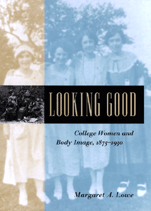Why Many First Year Female Students Will Dread Going Home Thanksgiving
If campus rumors and the recent spate of dieting books are to be believed, a good number of first year female students will return home for Thanksgiving a size or two larger than when they left. They have gained the dreaded “freshman fifteen.” Despite the fact that they were forewarned by such popular texts as Fighting the Freshman Fifteen: How to Lose Weight in College, How to Stay Fit on the College Meal Plan and Avoid the Freshman Fifteen, and Freshman Fifteen: A College Guide to Staying Health, Happy, and Holy, they have succumbed. They have enjoyed too many late night pizzas and all you can eat, dining hall meals – and now their bodies: softer, rounder, bigger – are about to be on display in front of the home crowd. Rather than looking forward to abundant Thanksgiving dinners and warm reunions with family and friends, they’re likely feeling anxious about food and apprehensive about their appearance.

How did they gain that weight? Similar to today’s students, they placed food at the center of their social life, but in contrast, seemed to feel little conflict about this. In regard to school fare, for example, a Cornell University student reported, “We have such delicious things to eat here. … I think the fish balls must have been fried like donuts. I never had any so good, & words are inadequate to even mention the excellence of that cream.” (No fear of fats or fried food here!) They held elaborate food parties (spreads) for almost any occasion, sharing food boxes filled with pies, crackers and sweets from home, and toasted welsh rabbit, and made fudge in the requisite chaffing dish. Not a binge, slip or dieting failure, they delighted in such occasions, enjoying the sensual pleasures of satisfying their appetites among friends.
Alas, this paradigm did not apply to non-white, non-middle-class students and lasted only a short while. Like today, food, appearance and dieting practices were class and race specific. African American women, for example, negotiated a very different terrain. To disprove their critics and combat virulent stereotypes, late nineteenth-century African American students adopted what Evelyn Brooks Higginbotham has called the “politics of respectability.” They used their bodies to enact quintessential notions of moral femininity in order to claim the rights and privileges it accorded. Thus at Spelman Seminary, its missionary founders prohibited food boxes from home and students adhered to strict codes of middle-class etiquette. An article in the school paper boasted, “When arranged [in the dining room] a hush fell over all .… Then began the music of knives and forks, and we could only wonder, the four hundred of these instruments should make so little discord.” Spelman’s school physician advised, students “would make greater proficiency be eating less, particularly of what we call rich food or that rich in grease, sugar, and spices.” For them, disciplined eating, and quiet, restrained appetites offered them the best chance for social and educational success.
And by the 1920s dieting among white women had become common place on college campuses. The 1925 Mount Holyoke College student handbook sounding only too familiar, warned incoming students: “Beware of eating between meals. Freshman traditionally gain ten pounds so patronize the ‘gym scales.’ ” Just about all of the factors we associate with problematic dieting today had coalesced by the 1920s – popularized medical dictums that linked health to appearance, mass media images that celebrated slenderness, and a powerful youth culture that emphasized conformity.
Certainly, earlier generations of white college students also faced their own set of cultural complications related to their bodies. Students who became ill or lost weight at college usually left without graduating. Assertive sexuality was castigated. Economic dependence left them vulnerable to marital pressures and appearance could determine one’s social fate. Still, it’s important to understand the “freshman fifteen” has a history. If once upon a time, white college women could stay up late, indulge in delicious treats and intellectual companionship, and wake up the next morning guilt-free, then we too might carve out a different path – one that offers a more peaceful, balanced and pleasurable future.